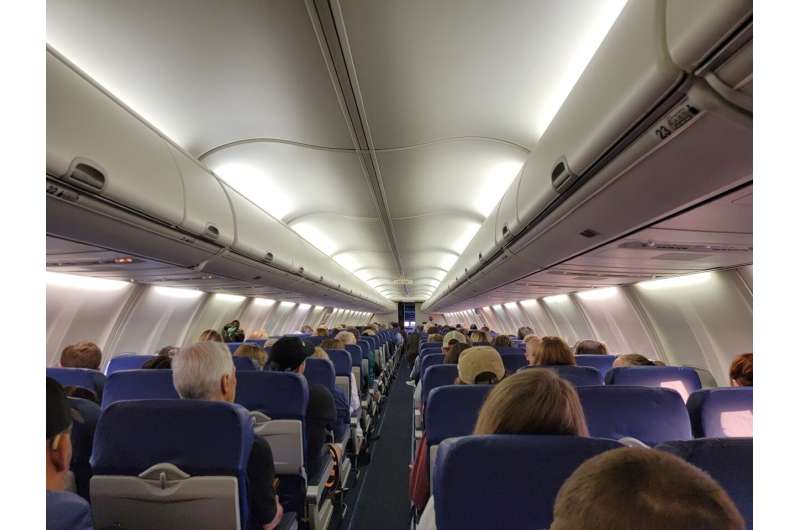Why Ryanair passengers were bleeding from the ears

A Ryanair flight from Dublin to Croatia had to make an emergency landing in Frankfurt recently after the cabin lost pressure. Following the ordeal, 33 passengers were treated in hospital, with some bleeding from their ears.
So why did the sudden descent cause ears to bleed?
Aircraft usually fly at an altitude above 30,000ft, climbing or descending to get there at a rate of about 2,000ft per minute. At 30,000ft the outside air pressure is about a third of that at sea level, causing gases to expand.
For comfort and safety, aircraft cabins are "pressurised" to an altitude of somewhere between 5,000-8,000ft, which is lower than pressure at sea level. This is why if you take a bag of crisps on the flight, it looks like it is about to burst, or when you get to your destination your shampoo has leaked into your bag. This pressurisation also helps to keep oxygen at a level that is safe for humans.
Normally, as the plane climbs, the air in the inner ear (see the diagram below) is at a greater pressure than the cabin because it is still the same pressure as when the aircraft left the ground, so the eardrum bulges out. During the climb, yawning, talking, drinking or swallowing causes the pressure in the ear to eventually equal that of the cabin pressure at cruise level overall, both end up being less than that at sea level).
When the plane descends, the air pressure in the cabin begins to increase towards that at sea level, while the inner ear remains at the lower cruise-level pressure, and so the eardrum gets forced inwards, causing muffled hearing – which you may have experienced when flying.
During normal ascent and descent, if you suck on a hardboiled sweet, take a drink or yawn, it can help open the Eustachian tube – which runs from your middle ear to the back of the nose – to allow the pressure in the inner ear to equalise with that outside the ear. Doing these things causes the opening in the back of the nose to stretch, allowing the air pressures to equalise.
Barotrauma
The Ryanair incident resulted from a loss of cabin pressure. This is where the mechanically maintained cabin air (held at the pressure representing 5,000-8,000ft) escapes to outside the aircraft where the pressure is much lower. This means that the air within the ear, which was also at a higher pressure (5,000-8,000ft), tries to escape. This is because the cabin has now dropped to the lower pressure of the outside of the aircraft.
At this high altitude, the pressure difference may result in "barotrauma", rupturing the eardrum and small blood vessels in the ear, causing hearing problems and bleeding. At this point, the packet of crisps would also explode.

Images on social media also showed blood-filled oxygen masks, probably the result of the rupture of small vessels in the roof of the nose as the change in pressure occurred. This was also likely the result of expanding liquids and gases that have to escape somewhere.
The biggest danger to passengers when a loss of cabin pressure occurs is asphyxiation. As the aircraft climbs into the atmosphere, the amount of naturally available oxygen in the outside air reduces to a level that is insufficient for effective breathing.
As well as maintaining pressure, the aircraft also ensures there is enough oxygen in the cabin. At sea level, 21% of air is oxygen, which is ideal for humans to breath. At 30,000ft and above, there is only about a third of that amount of oxygen available.
Oxygen saturation in the blood of a healthy human is usually between 94-98%. During flight, this reduces to the low 90s and in some cases into the 80s. The reduction in oxygen saturation towards 90% could have even more significant effects on those with heart or breathing conditions. This is why the oxygen masks deploy when cabin pressure drops – it ensures that every passenger has enough oxygen to saturate the blood.
Deployment of oxygen masks happens at the same time as the pilots descend as rapidly as possible to get to an altitude (usually below 10,000ft) where passengers can breathe without the aid of oxygen masks. This is because there is only a limited supply of oxygen (about 15 minutes) that is generated by special oxygen generators in the overhead panel.
Other unpleasant side effects
Luckily, these sorts of events are very rare. Air travel is extremely safe, with 2017 marked as the safest year to date. However, flying is probably never going to be entirely pleasant, even when things go well.
Ear problems – such as muffled hearing and popping ears – are experienced by everyone. But they are particularly unpleasant for people with colds, as their sinuses are full of mucus, which can block the opening of the Eustachian tube.
Teeth can also become sore during or after flights as air in the fillings and around the nerves expands and contracts. Unlike ear pain, chewing gum or sweets won't help.
And ears and teeth aren't the only places affected by rising and falling air pressure. During normal flight, the gas of the bowel also expands and contracts. As the aircraft climbs this gas expands, then on descent it becomes compressed again, often needing somewhere to escape. This is where people have to make the trade-off between social discomfort and physical discomfort.
As a result of this well-known problem, a group of researchers have suggested embedding active charcoal in aircraft seats to act as an odour absorber. Things can get better, even if they can never be perfect.
This article was originally published on The Conversation. Read the original article.![]()



















